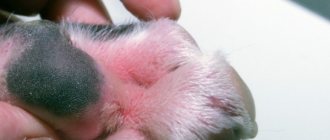General information
Distemper is a dangerous contagious infectious (viral) disease that occurs in several forms:
- hyperacute (lightning fast);
- subacute;
- acute.
The disease causes disruption of the functioning of the gastrointestinal tract and nervous system, causes fever, conjunctivitis, profuse diarrhea, acute catarrhal inflammation of the mucous membranes, and skin exanthema.
In addition to dogs, carnivore plague affects fur-bearing and predatory animals (raccoons, wolves, foxes).
This disease is especially dangerous for puppies and young (from two months to a year) unvaccinated dogs. Also, a weakened or unformed immune system plays a negative role, which increases susceptibility to the plague pathogen.
Veterinarians say that most often this disease affects German shepherds, huskies, staff terriers, Chinese crested dogs, bull terriers, Pekingese dogs, lap dogs, pugs and collies. While resistance to plague is manifested in terriers and mongrel dogs.
The disease has no seasonality, so animals get sick at any time.
The causative agent of the disease
A disease in dogs called canine distemper occurs as a result of infection with an RNA virus from the paramyxoviridae family. It is resistant to many environmental factors:
- UV radiation;
- sunlight;
- negative temperature.
At -20 °C, this virus can remain active in animal corpses for up to six months. It is also resistant to some disinfectants, and formaldehyde and bleach kill it only after three hours. In its dried form, it retains the ability to infect for up to four months, and heating to 100 °C destroys the virus in only two minutes.
In the external environment, the causative agent of canine distemper appears in dogs in the feces or secretions of animals that have recovered from the disease or are infected with a latent form of the disease.
What is distemper or canine plague?
The disease is viral and is characterized by high mortality in animals. In the wild, foxes, raccoons, ferrets, martens and sables, wolves and other animals suffer from carnivore plague. Among small pets, dogs are susceptible to distemper, especially puppies older than 3 months. This disease is also observed in cats, but cats tolerate the disease much more easily.
The causative agent of distemper in dogs is an RNA virus that belongs to the paramyxovirus family. The pathogen is highly resistant to low ambient temperatures, but quickly dies when boiled (after just a few minutes the virus is completely destroyed). In addition, the virus is sensitive to the effects of certain chemicals, such as formaldehyde and sodium hydroxide (2% solution).
The virus enters the dog’s body through the respiratory or digestive system, and then quickly spreads to all the dog’s organs through the bloodstream.
An adult dog infected with distemper almost always dies in the absence of qualified veterinary care. Young individuals and puppies tolerate the disease very hard; death from distemper in puppies occurs in 90% of cases. A recovered dog acquires lifelong immunity to the disease, but for about 3 months after recovery, the four-legged friend is a carrier of a dangerous virus, which means it is capable of infecting other healthy animals with distemper.
How does infection occur?
The main source of infection is the excretions of sick dogs:
- feces;
- urine;
- sputum;
- saliva;
- tears;
- sweat;
- pus from pustules on the skin.
Of particular danger is the fact that the onset of virus shedding in a sick animal occurs even before the symptoms of canine distemper in dogs clinically manifest themselves, and within ten days after recovery (in some cases, up to three months).
The methods of infection are also quite varied:
- direct contact with a sick dog (airborne);
- through water, food and utensils;
- when using only toys and bedding;
- through a person's clothing.
The likelihood of infection increases in the wet season with decreased immunity, poor feeding and care.
When infected, the virus spreads throughout the body through the bloodstream, affecting the respiratory and circulatory organs, immune, endocrine and nervous systems.
Canine distemper virus in cats and dogs
Carnivore plague
– a highly contagious infectious disease of carnivores, caused by the plague virus and affecting the gastrointestinal and respiratory tracts, as well as the skin and nervous system.
The canine distemper virus belongs to the family Paramyxoviridae
and affects ferrets and wild animals: coyotes, foxes, wolves, raccoons and skunks. The causative agent of the disease is quite stable in the external environment: at temperatures close to 0, it can persist for several weeks; in the organs of dead frozen animals it can persist for up to 6 months. When boiled, it dies instantly.
vaccinated are at risk
, and puppies aged 3 to 6 months (associated with a decrease in maternal antibody levels). Since wild animals also suffer from plague, contact with them increases the risk of infection.
Infection of a dog with canine distemper occurs both through direct contact with a sick animal, and through indirect transmission through dishes and care items. The virus spreads through saliva and nasal discharge when coughing
and sneezing, blood and urine.
Clinical symptoms
The main symptoms of canine plague:
• fever, • refusal to eat, • lethargy.
Other symptoms depend on the form of the disease:
• diarrhea
, • vomiting, • cough, • nasal discharge, • neurological manifestations.
From the time an animal is infected until the first symptoms appear, it can take from several days to 3 weeks. This is a hidden (latent) period during which the dog can already secrete the virus and infect other animals.
The first signs of illness are usually lethargy, refusal to eat, and increased body temperature. The dog is lethargic, moves little, does not eat regular food well, sometimes vomits, and its fur is disheveled. Further, the development of the disease depends mainly on which organ is affected.
1. The intestinal form is characterized by serious damage to the gastrointestinal tract. Vomiting occurs
, diarrhea, sometimes with blood, which quickly leads to dehydration.
2. In the pulmonary form, the respiratory system is affected. Rhinitis, tracheobronchitis, and then pneumonia
. The animal may cough and experience shortness of breath. Purulent discharge appears from the nose and eyes.
3. When the virus affects the spinal cord and brain, neurological symptoms begin: nervous excitement, vocalization, seizures, paralysis. Plague causes irreversible changes in the nervous system.
4. The skin form is characterized by the appearance of red spots on the skin of the abdominal wall, thighs, and ears.
5. Often the disease manifests itself in a mixed form, when several symptoms can be identified at once.
Diagnostics
Diagnosis is based on a combination of clinical symptoms, laboratory and instrumental diagnostic data. Since plague often leads to pneumonia, if suspected, it is recommended to take an x-ray
, and for diarrhea and vomiting -
ultrasound
.
A general clinical blood test can reveal leukopenia (decreased white blood cell levels). The most accurate way to identify the disease is by passing stool or nasal rinsing for PCR.
It is necessary to differentiate plague from other infectious diseases: adenovirus, parvovirus and coronavirus enteritis, leptospirosis, etc.
Treatment
Treatment of canine distemper is symptomatic and includes intravenous infusions of solutions, antibiotics, and immunostimulants. There is no specific antiviral therapy, so treatment depends on the main symptoms. At the initial stage of their manifestation, a special serum against viral diseases is used, the administration is repeated one or two more times.
For the pulmonary form, additional expectorants or antitussives and nasal rinsing are used. In the intestinal form - antiemetic drugs, adsorbents, hemostatic drugs and more.
It is also important to monitor blood tests
To adjust treatment, for example, if the level of red blood cells and hematocrit decreases below normal, a blood transfusion may be necessary.
Prevention
The main preventative measure is vaccination. The canine distemper vaccine does not guarantee that the animal will not get sick, but it greatly reduces the likelihood of the disease and also alleviates the course of the disease. The component is part of standard complex vaccines for dogs.
Incubation period and forms
The incubation period of the disease ranges from two days to three weeks. The only symptom of canine distemper in dogs during this period is lethargy and poor appetite.
According to the course of the disease, the disease is divided into the following forms:
- Fulminant - affects unvaccinated puppies at the age of two months. The only symptom is high temperature. Death occurs within 24 hours.
- Acute - develops quickly, begins with high fever and loss of appetite, then convulsions or paralysis appear. On the second or third day the animal falls into a coma and dies.
- Subacute – the dog has a fever from two days to two weeks, depression sets in and loss of appetite. Then characteristic signs of the disease appear.
- Chronic – after recovery, the disease periodically progresses.
According to the method of manifestation and, accordingly, the method of treatment in dogs, carnivorous plague is divided into the following forms:
- pulmonary;
- cutaneous;
- intestinal;
- nervous;
- hard feet – soreness and hyperkeratosis of the pads develop.
In eighty percent of cases, a disease occurs that combines several forms.
Symptoms.
The incubation period of the disease is 3-7 days, although in some cases it can reach 2-3 months.
Canine distemper is characterized by a very diverse clinical picture of the disease, determined by many factors: the virulence (degree of pathogenicity) of a given pathogen strain, the presence or absence of associated and secondary infections, as well as the physiological characteristics of infected animals (the state of the immune system, the presence of other pathological factors in the body, including non-communicable diseases, etc.). First of all, the plague affects the mucous membranes of the upper respiratory tract, digestive system, and eyes, which causes acute catarrhal inflammation and fever.
Plague can occur hyperacutely (lightning fast), acutely, subacutely, chronically, as well as typically and atypically.
The hyperacute course of the disease is characterized by a sudden rise in body temperature to 40-41°C, significant depression of the animal, refusal to feed, acute rhinitis and conjunctivitis. Then a coma suddenly sets in, and the animal dies on the 2-3rd day.
The acute and subacute course of the disease lasts 2-4 weeks and is characterized by a wide variety of symptoms. In adult dogs with a strong immune system, plague can only manifest itself as fever and depression of the general condition; in such cases, the disease lasts 3-5 days and ends with recovery.
With all the variety of symptoms, the clinical period (the height of the disease) begins in most animals, as a rule, with a sharp rise in body temperature by 1-3°C and acute catarrhal inflammation of the mucous membranes of the respiratory, digestive, genitourinary and other body systems. In the acute form of the disease, the high temperature is maintained for 2-3 days, in subacute (moderate fever) - 3-5 days; then the temperature drops slightly, but remains above normal by 0.5°C (in different breeds of dogs it can be 39.5-40.5°C).
During this period, sick animals are lethargic, mostly lie down, refuse food, but drink water. Dogs experience severe chills and general depression.
The mucous membranes of the eyes and upper respiratory tract are reddened, very swollen, first mucous membranes appear, and then abundant mucopurulent discharge from the eyes and nose, which gradually sticks together the eyelids and clogs the nasal openings. The skin on the nose is dry, cracks and deep wrinkles form on it, covered with dry purulent crusts. Dogs snort, sneeze often, and scratch their noses with their paws. Breathing becomes difficult (wheezing or wheezing), rapid and is 40-60 breaths per minute in large breed dogs, and 60-80 in small breeds. The pulse rate in sick animals also increases significantly and is 100-130 beats per minute in large breeds of dogs, and 130-170 in small breeds (in puppies these figures are correspondingly much higher).
Subsequently, if the animals have high natural resistance, the disease takes a benign course, and the dogs gradually recover. With reduced natural resistance of animals, if their treatment is not carried out, acute catarrhal inflammation of the mucous membranes and other membranes increases, causing profound pathological changes in the body, and the disease moves into the next stage of clinical development. It is at this stage, depending on the virulence of the pathogen and its localization, the individual, immunological and age-related reactivity of the body, as well as the presence of the above-mentioned associated and (or) secondary infections, that new “secondary” clinical signs of the disease are observed, which manifest themselves in the listed Below are the conditional forms.
Pulmonary (respiratory) - characterized by severe damage to the respiratory system: first the upper and then the lower respiratory tract. In this case, rhinitis, tracheitis, bronchitis, pneumonia or their mixed forms (acute catarrh of the upper respiratory tract, tracheobronchitis, bronchopneumonia) consistently develop, which can be diagnosed with careful auscultation and percussion.
Intestinal (gastrointestinal) - manifested by serious damage to the digestive system, including acute gastroenteritis, and is accompanied by refusal of food, vomiting, as well as constipation and diarrhea, which leads to dehydration and rapid exhaustion of animals. Feces contain mucus, often mixed with blood.
Nervous - characterized by severe, often irreversible damage to the nervous system, which most clearly manifests itself at the end of the disease. In the initial stage of the disease, short-term excitement, painful, prolonged barking, convulsive contractions, paralysis of the front and (or) hind limbs, and impaired coordination of movement are observed. In the future, with a favorable course of the disease, the nervous symptoms gradually weaken, appear less frequently or disappear completely. However, in some animals, limb paralysis or isolated nervous tics can last several months or remain for life. In the case of a malignant course of the disease, when both the spinal cord and the brain are affected simultaneously, long-term tonic-clonic convulsions with partial or complete loss of “consciousness” are observed in animals, i.e. minor or major epileptic seizures, the frequency and duration of which quickly increases, and the animals die.
Skin (exanthematous) - in addition to the general clinical symptoms of the disease, it is characterized by the appearance of small red spots on the inner and (or) outer surface of the thighs, abdominal wall, and ears. Subsequently, bubbles filled with clear or purulent contents form at the site of the spots, which then burst, dry out and fall off.
Mixed - manifests itself in animals with a wide variety of clinical signs listed above. However, in the mixed form of the disease, as well as in the nervous form, the main pathogenetic significance is the degree of damage to the central nervous system.
Course and spread of the disease
The virus penetrates mainly through the mucous membrane of the respiratory system, then entering the lymphatic system of the lungs. The pathogen multiplies in immune cells (macrophages, lymphocytes, monocytes) and lymph nodes. During the first ten days, the entire immune system is affected, and complications caused by bacterial and fungal viruses develop.
Further, the spread of the disease continues through the circulatory system and lymph and affects all organs and tissues. Despite global infection, symptoms appear one at a time or one after another. After seven days, nerve cells are affected, and after three weeks, the entire nervous system is affected.
The chronic course of the disease in dogs turns into the nervous form of canine distemper, which is characterized by changes in the character of the animal, the occurrence of paralysis and paresis, as well as epileptic seizures. If treatment is not applied and the disease develops further, the animal will die, caused by extensive paralysis of the nerve centers that control the functions of the heartbeat and breathing.
The course of the disease and its intensity largely depend on the dog’s immunity, the ability of its body to resist distemper and related diseases.
History of Domestic Distemper
The disease originated in Asia, spreading west toward Europe and across the Atlantic Ocean east toward the Pacific Ocean. It was widespread in Europe in the 16th and 17th centuries. Epidemics of rinderpest were associated with military campaigns. Giovanni Lanzisi, a famous Italian physicist and physician to Pope Clement XI, ordered the killing of all infected and hopeless animals. He also recommended inspecting the meat and burying the animals in lime. Those who ignored these laws were subject to severe punishments and sometimes even death sentences. Attempts have been made to inoculate animals, but these have been limited and not always successful in solving the problem.
England was hit by a massive outbreak in the early 1700s. Thomas Bates tried to emulate Lancisi's control measures, but less strictly, and his attempts were successful, almost completely eradicating the plague from England. But the plague made a fierce comeback in mid-century, and Bates' measures were not applied then, resulting in the death of half a million livestock.
A major outbreak was reported in the 18th century in Africa, killing over 80% of cattle. The Industrial Revolution had a negative impact on the spread of plague to livestock. The advent of steam cars meant that cattle could be transported across countries, signaling a dramatic increase in the spread of this virus. This led to the infamous rinderpest of 1865-1867 in Britain, which was called a national disaster. Massacres were carried out due to lack of medical care. For this reason, Europe had to ban livestock exports.
Symptoms of plague in animals
Distemper occurs against the background of other infectious viral diseases present in the animal. This could be adenovirus, coronovirus infection, canine parvovirus enteritis.
Carnivore plague manifests itself only as fever, lethargy, and apathetic behavior; if the animals have good body resistance to the disease, recovery occurs after three to six months.
The general clinical symptoms of the disease are:
- body temperature rises above forty degrees;
- symptoms of intoxication appear - nausea, vomiting, diarrhea;
- gray-green purulent exudate is released from the eyes, ears and sinuses;
- weight loss and loss of appetite;
- the animal is very thirsty;
- cough, runny nose appears, breathing becomes difficult;
- photophobia and lethargy occur;
- the pads on the paws thicken, the skin on the nose dries out;
- coordination of movements is impaired, gait changes;
- spasms, paralysis, convulsions, tonic convulsions, and epileptic seizures appear.
Accompanying illnesses
If the toxins affect the brain, meningoencephalitis develops, which causes the death of the dog. Canine plague also has an unfavorable prognosis when the central nervous system is affected.
The intestinal form is characterized by symptoms of dysfunction of the gastrointestinal tract, kidneys, liver - vomiting, hypersalivation, diarrhea. Dogs have a fever, refuse to eat, and drink a lot.
The pulmonary form of the disease causes shortness of breath, cough, rhinitis, inflammation of the ears, upper respiratory tract, and leads to bronchopneumonia.
The cutaneous form of plague is considered the mildest. It causes the appearance of a small papular-pustular rash in the peritoneum, tail, ears, and on the inner thighs. The pustules first fill with fluid, then pus and burst, drying out and forming brown, hard crusts.
Diagnosis of distemper in dogs
Sometimes an atypical stage occurs, which is difficult to diagnose due to the mild symptoms of canine distemper in dogs (and treatment is also difficult) - a slight increase in temperature, the dog’s changeable behavior. After fourteen days, signs of the nervous form appear, and after another month the animal dies.
In general, a veterinarian diagnoses a disease using regional epidemiological data and clinical signs of disease manifestation. To confirm the diagnosis, biochemical and laboratory tests, hematological tests and differential diagnostics are performed.
The following indicators are being studied to determine canine distemper in dogs:
- neutralization reaction;
- RN;
- immunofluorescence;
- indirect hemagglutenation reaction;
- RDP;
- bioassay for susceptibility.
Treatment of distemper in dogs
After receiving tests and establishing a diagnosis, the veterinarian prescribes an individual treatment regimen aimed at restoring immunity and organ functioning, as well as relieving signs of the underlying and associated diseases.
The article provides a description and photo of the symptoms of canine distemper in dogs. Treatment on the first day begins with antibiotics. In parallel, drugs of etiotropic, replacement and pathogenetic therapy, physiotherapeutic procedures, and hyperimmune serums are prescribed.
Sick animals are also prescribed:
- antihistamines, antipyretics (analgin, Diphenhydramine);
- astringents, sedatives and antivirals (“Loperamide”, “Mydocalm”. “Aminosin”);
- vitamin and mineral complexes to maintain general condition;
- immunomodulators to correct the body’s resistance;
- sulfonamides and painkillers (“Travmatin”, “Baralgin”);
- hepatoprotectors and expectorants;
- anti-inflammatory and topical drugs (“Chlorhexidine”, hydrogen peroxide, “Dexamethasone”).
To restore the functions of the gastrointestinal tract, nutritious and water-salt solutions are used, and specific diets and enzymes are prescribed. After a course of antibiotics, the pet is given probiotics (“Bifidumbacterin”).
The fulminant and hyperacute forms give a completely unfavorable prognosis, the combined form is often unfavorable, and all the others, with timely treatment, lead to a complete recovery and the establishment of lifelong immunity.
Methods of treating the disease
Although the disease is common and easy to diagnose, treatment of plague with specific drugs has not been developed. You can only strengthen the immune system, eliminate pathological signs, and compensate for the impaired functioning of internal organs. An important point is the elimination and prevention of secondary infections and systemic diseases of dogs.
Basic principles of treating the disease:
- diet food - fasting diet for a day, then light food;
- therapy of the respiratory system - inhalations, warming the chest, expectorants;
- restoration of the digestive organs - the use of adsorbents, enveloping agents, artificial nutrition through the rectum, artificial enzymes, hepatoprotectors;
- intravenous and subcutaneous administration of isotonic salt solution, glucose, plasma substitutes;
- painkillers and antipyretics;
- a course of antibiotics and antimicrobials;
- Magnesium sulfate, nootropil for nervous clinic.
It is important to create good conditions during the recovery period. Warm, dry rooms without drafts should be maintained. Eliminate all sudden noises, as stress greatly worsens the nervous form of the plague. Until the animal gets better, it is better not to walk it. Be sure to isolate your pet, since there is a high probability of infecting other animals, but this virus does not pose a threat to people.
The most common method of therapy at home is treating plague with vodka. Indeed, alcohol can be used, but vodka should be used to moisten compresses that warm the chest of an animal in the case of a pulmonary form. Pouring vodka down the throat of a sick animal is extremely undesirable, as this leads to a worsening of the condition, complicates the use of medications, and makes it impossible to diagnose the disease.
Good folk remedies are:
- a decoction of bird cherry fruits and oak bark to relieve inflammation of the digestive system;
- coltsfoot, cumin as an expectorant for the pulmonary form;
- compresses, mustard plasters for pneumonia;
- belladonna infusion to relieve pain.
Antibiotic treatment is used to suppress secondary infection. Drugs are selected taking into account the sensitivity of microbes, and at the onset of pathology, broad-spectrum antibiotics are prescribed. If you do not test the sensitivity of bacteria, the cost of such treatment can be very high - in most cases, the cause of death of puppies is not distemper viruses, but secondary microbes.
General disease prevention
Timely vaccination of dogs against canine distemper will help protect your pet from infection with a dangerous virus. The first vaccination for puppies is given at one and a half months of age, and then annually. The appearance of immunity after vaccination does not occur immediately, but after a month (after revaccination).
To spot signs of a dangerous disease in time, animal owners must:
- treat your pets carefully;
- monitor their health;
- systematically carry out hygiene procedures;
- to keep clean;
- feed properly;
- include mineral and vitamin preparations in the diet;
- When walking, avoid contact with street dogs.
There are two vaccines against canine distemper:
- with a weakened virus – protects for a year, but gives complications in the form of fever and swelling;
- with a dead pathogen - the effect is less pronounced, but there are no complications, the vaccination is repeated three times a year.
Among domestic vaccines, Multikan-6.8 follows, and among foreign drugs, the effective use of Nobivak, Dipentovak, Pentodog, Kanvak, Hexodog and Vanguard.
It is advisable to carry out revaccination with the same drug as the first vaccination, in order to avoid conflict of strains in the composition of different medicines.
Most often, animals do not react to the vaccine, but mild swelling and pain at the injection site and a slight increase in temperature may occur.
Before vaccination, the dog must be examined, and after it, the pet must be monitored.











